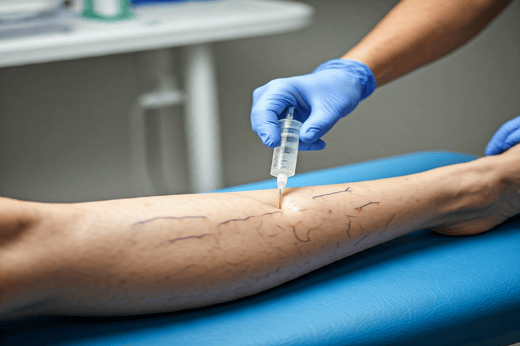
Minimally invasive procedures are gaining immense popularity in medicine since they offer a cascade of benefits. They do not involve anesthesia (numbing agent), incisions (cuts), hospitalization, post-procedure severe complications, or long recovery time. “Sclerotherapy” is a popular minimally invasive procedure for treating varicose veins. These are common medical conditions that cause twisted, enlarged veins, especially in your lower legs, due to venous insufficiency (occurs when your veins do not allow blood to flow back to your heart and get pooled, causing swelling). Sclerotherapy involves injecting special chemical solutions into the affected veins to shrink them.
In this article, we will explore the uses of sclerotherapy, how to prepare for it, what to expect from the procedure, and what recovery entails.
Sclerotherapy is a minimally invasive, non-surgical procedure for treating varicose and spider veins, usually on the lower legs. It involves injecting a chemical solution, called a sclerosant, using fine needles directly into the affected vein. The injected solution irritates the blood vessel lining, which expands and sticks together, forming a scar. This closes off the affected vein, improving its appearance.
Sclerotherapy is a first-line treatment for varicose veins caused by chronic venous insufficiency. Varicose veins appear due to poor functioning one-way valves, blocking the blood supply within the affected vein. This results in swelling of the veins, causing itching, pain, and discoloration.
Sclerotherapy may also be needed in other medical conditions such as:
Doctors might consider sclerotherapy if you experience any of the following signs of varicose veins:
Your doctor refers you to a vein specialist for further evaluation. The specialist will record your symptoms and medical and family history. Follow the below-mentioned guidelines before your scheduled sclerotherapy treatment:
Sclerotherapy is an outpatient procedure (there is no hospitalization) that lasts for 30 to 45 minutes. You can expect the following steps involved in sclerotherapy:
You will be kept under observation for an hour before you are allowed to go home. After the procedure, you can expect mild irritation or tingling sensation, which is normal and may resolve gradually. You will return to your routine activities immediately or the following day.
Furthermore, your doctor will advise you to do the following:
The results of sclerotherapy for smaller varicose veins usually show in 3 to 6 weeks, while for more prominent veins, it may take 3 to 4 months. However, you might need more than one treatment for the desired results.
Benefits of sclerotherapy include:
As with any medical procedure, you may encounter side effects after sclerotherapy. These include:
Varicose veins can be problematic to live with, but with the advent of minimally invasive procedures like sclerotherapy, you can overcome the painful symptoms. Sclerotherapy is a minor, non-surgical procedure to treat medical issues like varicose veins or hemorrhoids. It involves injecting a sclerosant into problematic veins to shrink and collapse them. The procedure is generally safe and effective if performed by an experienced vein specialist. However, the success of sclerotherapy depends on the severity of varicose veins since advanced stages may require more extensive treatments like surgical intervention. You may need multiple sessions to eliminate varicose or spider veins.
If you are distressed due to the painful symptoms of varicose veins, consult your doctor and discuss if sclerotherapy is the right choice of treatment for you.